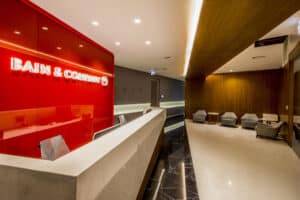McKinsey & Company (more commonly known as McKinsey) is one of the world’s top-3 management consulting firms, together with BCG and Bain. It is also one of the most selective employers in the world.
Unparalleled in its reach and prestige, McKinsey is the largest of the top-3 consulting firms, with over 45,000 employees in over 130 cities globally. Now approaching its centenary, it has long held the reputation of being the industry leader. In 2022, its worldwide revenue was $15b.
In this article we take an in-depth look at McKinsey, including a brief history of the firm, what it’s known for, its culture, and what it’s like to work there. We also consider how candidates can articulate their motivation for applying to McKinsey.
A brief history of McKinsey
McKinsey was founded by James O. McKinsey in Chicago in 1926. The firm’s first Partners were Andrew T. Kearney, who joined the Chicago branch in 1929, and Marvin Bower, who was hired in 1933 to manage the firm’s new branch in New York.
Kearney and Bower split the firm in 1939 following the death of James McKinsey in 1937. Kearney continued to run the firm out of Chicago as A. T. Kearney and Company, which is still in operation today as Kearney. Marvin Bower, meanwhile, teamed up with some of his fellow Partners in New York to relaunch the office there as McKinsey & Company.
Described by Harvard Business Review as “the father of modern management consulting”, Bower is credited with establishing McKinsey’s values and principles, which remain integral to the firm today. The internal publication authored by Bower, Perspectives on McKinsey – which details the firm’s methods and principles – is still given in its original form to all new joiners. Although Bower’s years of actively leading the firm spanned from 1950 to 1967, he remained a leadership figure at McKinsey until 1992.
The firm has made several acquisitions to develop its capabilities in a number of emerging areas. These include sustainability, climate change and design, as well as data science and AI, with the acquisition of QuantumBlack (now QuantumBlack AI by McKinsey) in 2015. This made McKinsey the first consulting firm to enter the AI space, and earned the firm a reputation of having a pioneering approach towards adopting new technologies. In 2023, it became the first management consulting firm to adopt generative AI as part of its consulting toolkit.
Over the years, McKinsey has developed new ways of serving its clients beyond the provision of traditional consulting services. Through ‘asset-based consulting’, the firm leverages advanced technology, proprietary data and deep expertise to deliver solutions in the areas of diagnostics, market intelligence management technology and analytics.
What is McKinsey known for?
Areas of expertise
For senior leaders at most top global organizations, McKinsey is the go-to adviser across a range of critical questions, from strategy and operations through to digital. The firm has been the pioneer of bringing the strategy consulting approach deeper into its client organization, through functional practice areas. Today, the firm’s size allows it to offer its clients unparalleled expertise in virtually every industry and function.
Controversies
As the market leader, McKinsey is subject to a great deal of scrutiny – greater, perhaps, than other top management consulting firms – and has been criticized for playing a role in a number of controversies over the years:
- The firm is said to have encouraged some of its Wall Street clients to adopt practices that contributed to the financial crisis of 2008 and subsequent global recession.
- From 2004-2019, McKinsey advised Purdue Pharma, the makers of Oxycontin, the drug that fueled the ongoing opioid epidemic in the United States. In 2021, McKinsey paid $600 million to settle investigations into its role in promoting sales of OxyContin and helping Purdue Pharma circumvent regulation.
- Additionally, the firm has been accused of supporting authoritarian regimes by working with clients such as the Saudi Arabian monarchy, Turkey’s autocratic president Recep Tayyip Erdogan, and several Chinese and Russian companies operating under sanctions.
In the wake of these headline-making stories, the inner workings of McKinsey have been the subject of a number of management consulting books, including The Firm: The Inside Story of McKinsey, The World’s Most Controversial Management Consultancy by journalist Duff McDonald.
Alumni
Known for being a ‘CEO factory’, McKinsey has many notable alumni, including Google’s Sundar Pichai, former Facebook COO Sheryl Sandberg, and Chelsea Clinton.
What is McKinsey’s culture?
The world of McKinsey can be described as one that values intellect over experience, influence over compulsion, logic over emotion, and fact over gut feel. It’s also a place that is outwardly positive and upbeat, and where very little is seen as impossible.
There are a number of other factors that make the working culture at McKinsey both unique and appealing:
McKinsey colleagues are incredibly collaborative and helpful
Despite the fierce competition to get into McKinsey, the culture inside the firm is one of collaboration and support. People are always willing to help, and often take pride in being the most helpful person in a group. If a consultant sends an email to their office, practice or cohort about a client-related question or challenge, they can expect to receive a large number of responses from their colleagues.
Everyone has a voice on a McKinsey project team; it’s not at all uncommon for a new hire to discuss a point with a senior Partner during a problem-solving session. As a result, McKinsey can feel like a very flat organization.
There’s also a real sense of people caring about each other. Decisions – such as those on project staffing – are often driven by what’s best for an individual and their development.
This culture of support and collaboration is enabled by McKinsey’s approach to promotions. Instead of limiting the number of promotions it can award, the firm promotes anyone who demonstrates the level of performance required at each stage of the consulting career path.
Feedback is integral to the culture at McKinsey
At McKinsey, feedback is used as a tool to help colleagues continually improve the way they work and raise the bar when it comes to their performance. The firm’s feedback model is one of the first things that new joiners learn.
Feedback at McKinsey is both frequent and expected. At a minimum, it will take the form of a 20-minute chat between consultant and manager every two weeks. However, it’s common for additional feedback to be provided on an ongoing basis in relation to a consultant’s day-to-day activities. This will include the client meetings they participate in, the presentation decks they prepare and the data modeling they undertake. The goal of the feedback is to help consultants learn and improve in the shortest amount of time, and to create a cohesive culture in which everyone works in a similar way.
In addition to receiving frequent ‘downward’ feedback from their manager and more senior colleagues, consultants at McKinsey are also expected and encouraged to provide upward feedback to their peers and higher-tenured colleagues.
Excellence is in McKinsey’s DNA
Given McKinsey’s enduring elite status in the consulting world, it’s no surprise that the firm sets the highest of standards in every area of its operation. The pursuit of excellence touches everything that McKinsey does, from its professionalism to the quality of the presentations it produces for clients, the rigor of its analyses, and the work ethics of its consultants.
McKinsey’s commitment to excellence is underpinned by its approach to reviewing the performance of its consultants regularly. Those who do not meet the required standards are often asked to leave the firm under its ‘up or out’ policy.
McKinsey is committed to its values
McKinsey is fiercely committed to upholding its values. In light of the recent controversies in which the firm has been embroiled, this is perhaps more true now than ever before.
McKinsey’s values are:
- Adhere to the highest professional standards: this means putting client interests ahead those of the firm, observing high ethical standards, and preserving client confidences.
- Improve our clients’ performance significantly: this means following the firm’s ‘top-management’ approach, pursuing holistic impact, and using the firm’s global network to deliver the best results for its clients.
- Create an unrivaled environment for exceptional people: this means being non-hierarchical and inclusive, developing one another through apprenticeship and mentoring, and upholding the right to engage or dissent. If any team member believes that work is not being done in the best interests of the client, or that the firm’s values are not being upheld, they have a mandate – and responsibility – to object.
What is it like to work at McKinsey?
Here are some of the ways in which McKinsey’s culture translates into the experience of working at the firm.
McKinsey has a very international, ‘one-firm’ community
The McKinsey culture is incredibly international. While consultants are part of an office in a specific location, several different nationalities can often be represented in a single project team. There are also opportunities for consultants to work on short-term global projects and, for longer-term projects, to relocate to a new office.
As knowledge and expertise is shared openly among offices, McKinsey consultants often seek the input of industry experts in different states, countries or even continents. The firm’s training events, which are attended by consultants from around the world, provide an additional opportunity for colleagues of different backgrounds to connect and interact.
Although McKinsey’s consultants are from a wide range of locations and backgrounds, they all tend to think, talk and communicate in a similar way. Assemble a group of McKinsey colleagues from offices around the world, and they’ll immediately come together and start working naturally as a single team.
A former McKinsey consultant on our coaching team tells us: “During my time at McKinsey, I was able to serve clients across six countries out of two major hubs and three offices. I was a coach and interviewer across all these geographies and saw the consistency of McKinsey’s standard for hiring first hand. The firm’s expectations were always the same, which ensured that the quality of talent was consistently high in every location.”
McKinsey colleagues are impressive and diverse
McKinsey is a melting pot for those who have been conventionally successful, from graduates of prestigious universities like Oxford, Harvard and Yale, to alumni of Google, Goldman Sachs and the military. It’s not uncommon to come across McKinsey consultants who have been Olympic gold medallists, extremely senior members of government, or even rocket scientists.
Engineers, data scientists and UI/UX designers also feature in McKinsey’s population as a result of its recent focus on developing capabilities in areas such as digital, sustainability and AI through its expert career track.
Our research into recruitment at McKinsey, BCG and Bain (MBB) illustrates McKinsey’s commitment to hiring a diverse pool of candidates. In our analysis of MBB hiring around the world, we found that McKinsey hired the most MBA graduates with an international background. It was also the firm that hired the most candidates from outside of a country’s top university. And in our analysis of gender parity in MBB hiring, we found that McKinsey made the highest number of female hires.
McKinsey has its own language
At McKinsey, there are endless acronyms for all sorts of internal phrases. A consultant might say: “Fill out your EPR after you’re done with FLITE, but make sure your EM talks to the AP before it’s passed on to your DGL or PD.” While this language will be virtually meaningless to most people, other McKinsey consultants will be able to translate it easily.
Academic terms are another common feature of the McKinsey vernacular: a project is a ‘study’, temporary postings are ‘fellowships’, and colleagues who have been at the firm a long time are ‘higher-tenured’ than new joiners. This type of language lends something of an academic feel to working at McKinsey.
As the Myers-Briggs personality framework is widely used within the firm, consultants also tend to refer to Myers-Briggs type indicators (MBTI) in relation to themselves and others.
PowerPoint is used extensively
Although it has made efforts to move away from this recently, McKinsey has a strong bias towards using PowerPoint. Junior consultants spend hours creating decks, and McKinsey even has a full-time offshore graphics team to provide support with designing slides.
McKinsey consultants work collaboratively with clients
When it comes to the work that consultants do, the classic McKinsey approach is to collaborate with clients every step of the way: sitting in their offices, testing and refining ideas with them, and delivering interim recommendations with their input.
Because consultants co-create solutions with their clients, the final meeting usually contains very few surprises. As a result, there is rarely a single ‘big bang’ presentation at the end of a project.
The environment can be stressful
At McKinsey, consultants work long hours under a great deal of pressure and scrutiny. As a result, some can become overwhelmed, burn out, and even get sick.
In recent years, there has been a sincere attempt on the firm’s part to address this by introducing initiatives designed to improve consultants’ work-life balance. McKinsey’s ‘Take Time’ program, for example, allows consultants to take an additional 10 weeks of unpaid leave during the year.
While improvements have been made in this area, the firm’s mission to over-deliver for clients tends to make the environment at McKinsey naturally stressful, and the desire to improve work-life balance is among the reasons why many people leave consulting after two to four years.
McKinsey is both structured and fluid
While McKinsey teaches its consultants to think in a highly structured way, the organization itself is somewhat fluid. Consultants often have a say in the projects they work on, but sometimes also have to travel to work in another office with just a couple of days’ notice. Projects have managers and leading Partners, but consultants don’t have a set ‘boss’.
Rules are rarely codified and seldom enforced to the letter at McKinsey. Exceptions can always be made, and the strength and breadth of a consultant’s internal network will often determine which way something will go. It’s an organization driven by norms, values and networks, rather than regulation and process.
McKinsey is an affluent and rarefied place
At McKinsey, consultants’ lunches and dinners are usually paid for, taxis and rental cars are readily available, and there is a generous policy on hotel rooms and meals for business travel. While it’s not a culture of excess, it’s certainly one of comfort: whatever happens, consultants know they can expect everything to be taken care of.
How to answer the “why McKinsey?” question in an interview
Unlike in the fit interviews at BCG and Bain, this question isn’t a formal part of McKinsey’s Personal Experience Interview (PEI). However, articulating your reasons for applying to the firm in a clear and compelling way can certainly be helpful when it comes to creating a good impression with your interviewer.
Aim to be as specific as possible in your answer and avoid making generic statements. Having an example of how your strengths, goals or values align with the firm can be especially effective. This might be in relation to the work that McKinsey does, the types of clients it supports or its working culture.
It can also be helpful to highlight the research you have done into life at the firm, and to articulate why you have built such a positive impression.
If a career in management consulting sounds like it might be right for you, you can learn more in our complete guide to the management consulting industry. And if you’re preparing to apply to McKinsey, the resume and cover letter templates and specialized advice in our Free Resume Course will help you get your application in great shape.







